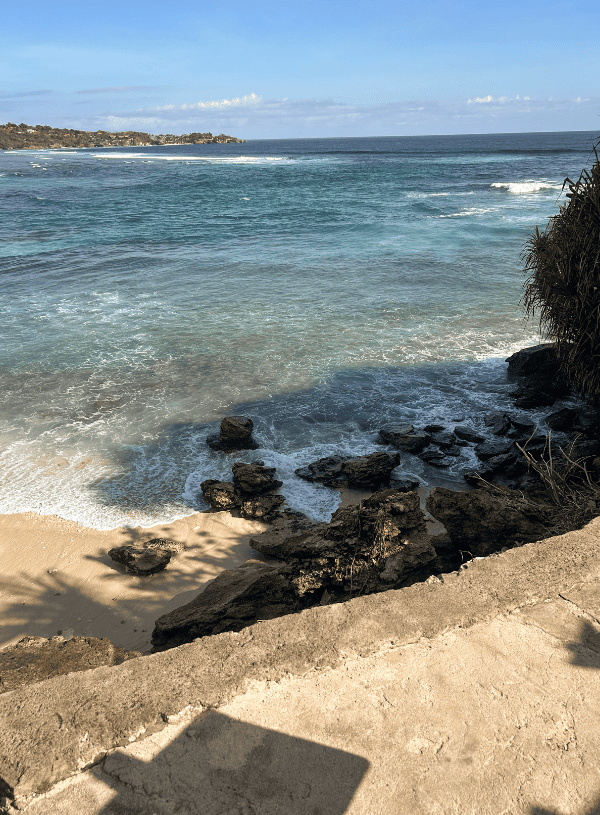Pura Tirta Empul Purification Ritual: Your Guide to Bali’s Sacred Water Temple
Last Updated on October 26, 2025
Experiencing the Pura Tirta Empul purification ritual can be one of the most meaningful and unique moments of a trip to Bali—especially if you believe in the power of rituals, intention, and water to cleanse body, mind, and soul.
This sacred water temple has become a magnet for travelers seeking unique experiences. Thanks to its holy spring—part of Bali’s ancient Subak irrigation system—Pura Tirta Empul is considered one of the island’s most important temples.
But even with its deep cultural and religious significance, the experience may not always feel like the intimate purification ceremony many people expect.
In this blog post, I’m sharing my honest thoughts and personal experience of witnessing the Pura Tirta Empul purification ritual (I didn’t take part, and you’ll discover why), so you’ll know exactly what to expect before visiting. I’ll also suggest alternative temples in Bali where you can experience a more private and meaningful blessing.
This article may contain affiliate links. This means that if you purchase through one of the links, I may be paid a small commission at no extra cost to you. Thank you for supporting the blog and allowing me to keep sharing meaningful travel experiences with you.
Don’t have time now?📌 Save it for later!

Recommended In This Article
Is Pura Tirta Empul worth visiting?
Yes — Pura Tirta Empul is absolutely worth visiting, whether you decide to take part in the purification ritual or not.
Located in the spiritual village of Tampaksiring, this ancient water temple dates back to 962 AD and is dedicated to Vishnu, the God of water. Its sacred spring — tirta empul literally means “holy water spring” — continuously feeds fresh water into the pools where the purification ritual takes place.
Beyond the ritual itself, Pura Tirta Empul is also one of the most impressive temples near Ubud. Set in a lush valley, surrounded by deep jungle and close to other spiritual sites like Pura Mengening, the atmosphere feels uniquely powerful and serene at once.
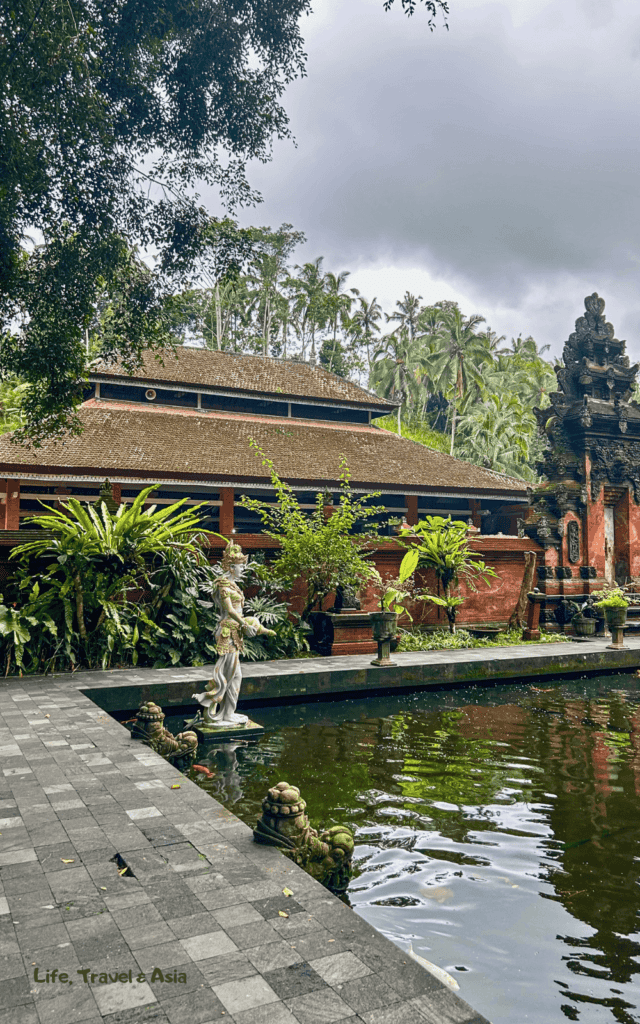
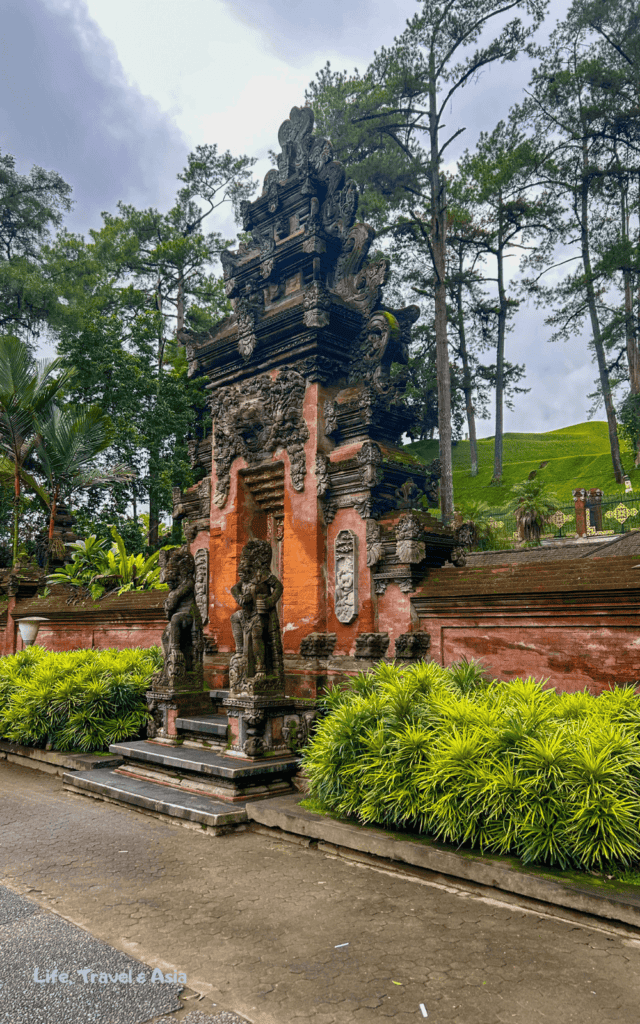
Architecturally, it’s a stunning example of a Balinese Hindu temple: three beautifully structured courtyards, imposing red sandstone gates, and a sacred inner courtyard where locals gather to pray and make offerings.
Visiting this temple allows you to learn more about Balinese Hindu traditions and daily spiritual life.
What struck me the most was the dramatic energy shift: the busy outer courtyard, crowded with visitors lining up for the Tirta Empul purification ritual, and then — just steps away — the quiet inner sanctuary where the holy spring is located, silent and untouched. It was almost as if you were walking between two completely different worlds.
Planning Your Visit
1. How To Get There
Getting to Pura Tirta Empul from Ubud is super easy. The temple is located about 16 km north of town, in the village of Tampaksiring — roughly a 30-minute scooter ride if traffic is light. You have a few options for getting there:
- Rent a scooter: The roads to Tirta Empul are generally well-paved. If you feel confident driving in Bali traffic, this is the most flexible and budget-friendly choice.
- Grab/Gojek: If you prefer not to drive, you can book a Grab or Gojek ride to get there and come back. Many drivers are happy to wait or take you to other nearby attractions — just negotiate the price beforehand.
- Join a tour: Group tours usually include hotel pickup and drop-off. However, I personally wouldn’t recommend visiting the temple as part of a tour — they typically arrive during peak hours, when the crowds are at their worst.
2. Best Time To Visit Pura Tirta Empul
I visited Tirta Empul in the early afternoon — and based on that experience, I would only recommend going between 7:00 and 9:00 AM, or after 5:00 PM if you prefer a quieter atmosphere (although I haven’t personally tested the evening yet).
The Pura Tirta Empul purification ritual has become extremely popular in recent years. Almost every Ubud day tour stops here, so from mid-morning until late afternoon, the temple gets crowded, queues get long, and the experience can feel more rushed and chaotic than spiritual.
The temple is also busier during full moon ceremonies. As for the best time of year, Tirta Empul can be visited year-round. Just keep in mind that peak tourist seasons — July, August, and the Christmas/New Year holidays — are naturally busier.
🔔 Avoid practicing the ritual right after a meal (if possible). The water is usually cold, which may affect your digestion.
3. Entrance Fee and How to Join the Ritual at Pura Tirta Empul
You can absolutely visit Pura Tirta Empul without taking part in the purification ritual. The entrance fee is IDR 75,000 (for adults), and it includes a sarong you’ll receive at the entrance.
If you do want to join the Pura Tirta Empul purification ritual, you have two main options:
1. Arrange it directly at the temple: You can find a temple “guide” who will lead you through the steps of the ritual. There is no fixed price. You’ll need to negotiate, and guides may try to push for higher rates. Additional costs to consider:
- Ceremonial sarong: IDR 10,000 (different from the one you’re given at the entrance)
- Locker: IDR 15,000
- Small Donation for the canang sari offering
2. Book a guided ritual experience in advance (around $17): This is not the same as joining a big group tour. Instead, you’ll have a private or small-group guide who will support you throughout the purification experience. All fees and elements of the ritual are usually included, so you won’t have to worry about unexpected add-ons.
🔔 Everything must be paid in cash. Cards are not accepted at the temple. Make sure to bring small bills, as change is not always available.
4. Do I Need A Guide To Partake In The Ritual?
A guide is not mandatory. However, if you want to understand the meaning behind the purification ritual fully, I strongly recommend having one. The ritual is not just about stepping into the pools and bathing under the fountains. It’s about intention, gratitude, and offering — connecting with the water on a spiritual level.
Not all fountains are used for the melukat purification. Some are reserved for specific ceremonies. A local guide will make sure you follow the correct order and avoid anything that may be inappropriate.
Beyond the practical aspect, a guide can help you shape your personal experience — because each ritual can feel different depending on what you’re seeking and what you’re letting go of.
5. Dress Code For The Purification Ceremony
Since Pura Tirta Empul is a sacred place, you’ll need to dress appropriately. You’ll be given a sarong right at the entrance, so you don’t need to worry about bringing your own.
If you’re joining the melukat purification ritual, you’ll then change into the ceremonial sarong (the bright green one you’ll see everyone wearing).
Wear your swimsuit under the sarong. You’ll keep the sarong on in the water — going in only in a swimsuit isn’t allowed.
🔔 Women during their period can’t participate in the ritual, as this is considered a sign of disrespect for the sacred waters.
Pura Tirta Empul Purification Ritual: 5 Steps
The Melukat Ritual is a Balinese Hindu purification ceremony that cleanses the spirit, mind, and body of negative energy and restores balance. “Melukat” literally means “purification for goodness and happiness“.
Locals usually perform this ritual on auspicious days —times of renewal and spiritual significance —such as full and new moons, the last day of Nyepi, and other special occasions.
Temples aren’t the only places for Melukat; sacred waterfalls and rivers, with their naturally peaceful vibes, are popular spots for spiritual ceremonies.

The ritual, no matter where you practice it, usually follows the same steps and structure (though it may vary depending on the guide).
Step 1: Get Changed
The first step is getting changed into the ceremonial sarong. There are on-site changing rooms, and you can leave your belongings in the lockers before heading to the pools.
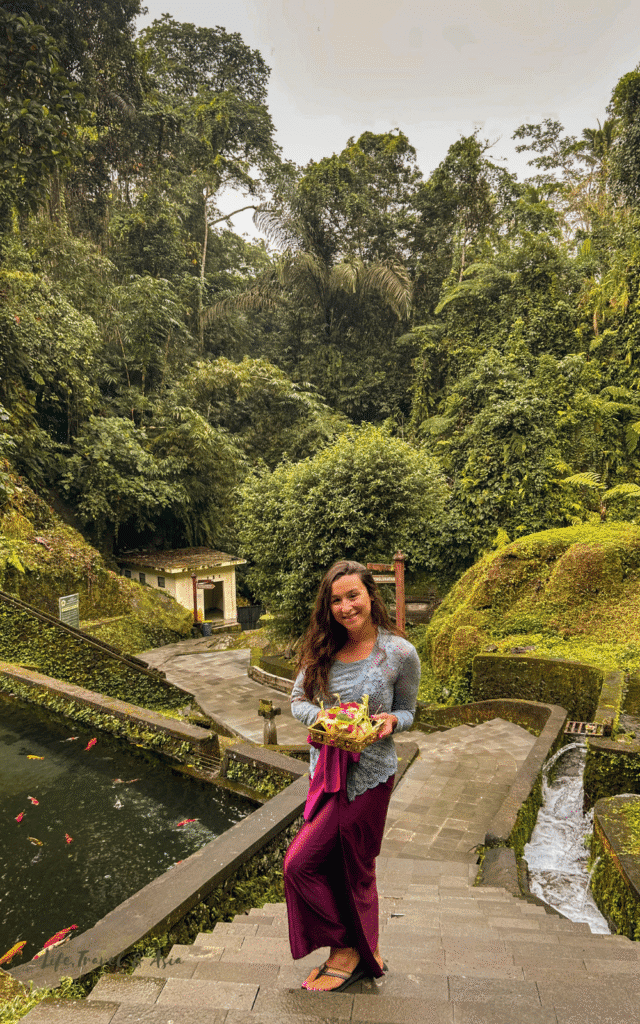
You’ll keep your swimsuit on, add flip-flops, and wrap the ceremonial sarong over it. Women will also be asked to tie their hair up before entering the water.
🔔 When I practiced the melukat at Pura Mengening, I actually had to get changed twice. First, I wore the traditional women’s temple attire — top, sarong, and sash — to enter the temple grounds and take part in the prayers. Only afterward, before the bathing part of the ritual, did I change into the ceremonial sarong.
Step 2: Meditation & Offering
The first meaningful part of the ritual is the offering and prayer. Locals begin by placing a canang sari — a small offering made with colorful flowers and an incense stick — as a sign of gratitude.
It doesn’t matter what you believe in. This is a moment to pause and acknowledge the blessings you already have, whether you’re thanking God, the universe, or simply life itself. Then comes the prayer: releasing what no longer serves you and setting intentions for what you want to welcome in.
This takes place right in front of the altar, just beside the bathing pools.
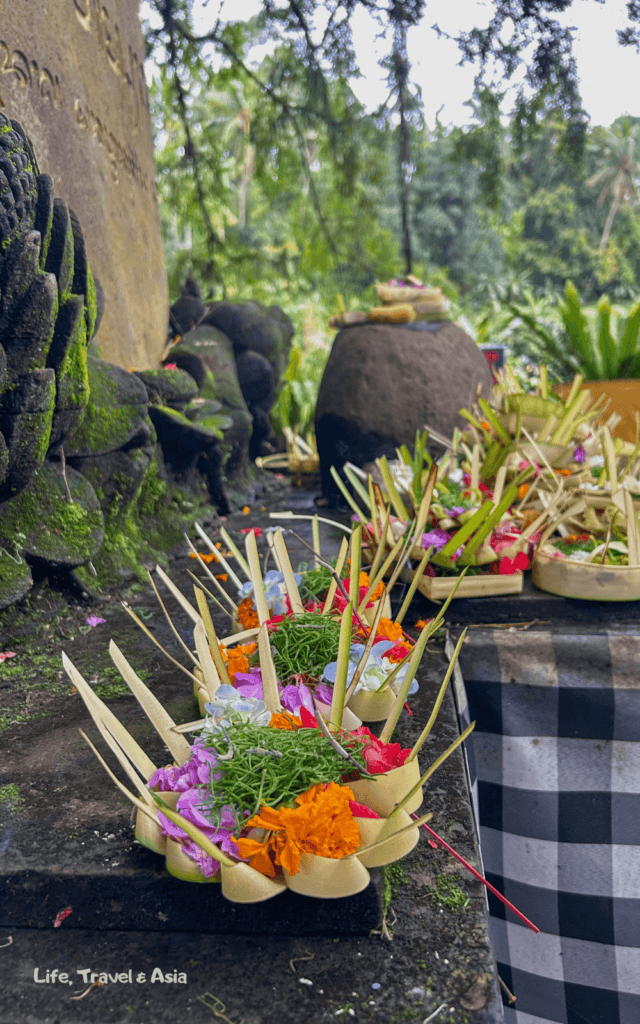
Step 3: Bathing Pools
There are three pools at Pura Tirta Empul, each with a specific number of fountains you’ll need to bathe your head under. While passing under the fountain, you ask to be released and cleansed by the holy water of what no longer serves you.
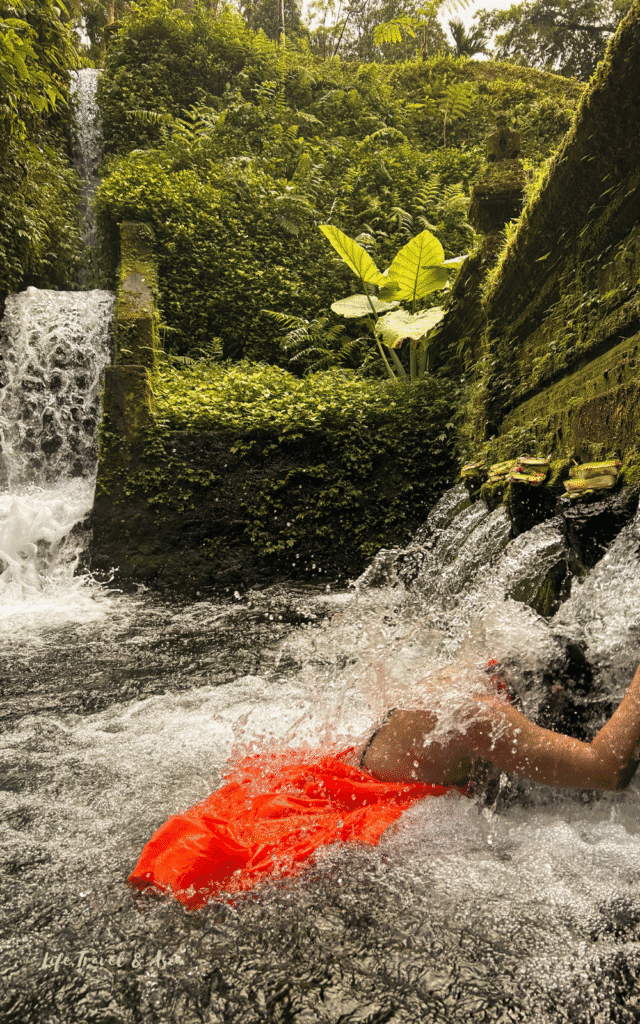
Step 4: Third Pool
You should start on the right side of the third pool. However, most people focus only on the leftmost fountain, which is supposedly the most powerful and the one the temple is named after.
Step 5: Final Meditation
Once you finish, you can change back into your dry clothes and return to the altar for the final prayer — a much shorter moment where you once again focus on gratitude and give thanks.
The ritual ends with the guide sprinkling holy water over your head. The guide may place some rice on your forehead and your neck, near the jugular area. Rice put on the body is believed to bring prosperity and good fortune.
🔔 The ritual is usually made of these five steps — this is precisely how I experienced it at Pura Mengening. However, depending on your guide or the group you join, the process may vary slightly. Some parts, like the final meditation or the canang sari offering, may be skipped or simplified.
Is The Pura Tirta Empul Purification Ritual Authentic?
During my first trip to Bali, I was really looking forward to experiencing the melukat ritual. I imagined something peaceful and meaningful. But when I arrived and saw how chaotic the atmosphere felt, something was just… off. I decided not to do it.
Part of it was the guide — and unfortunately, a guide can make or break this kind of experience.
But the temple itself felt extremely touristy: people taking selfies in what is supposed to be holy water, long queues to get under each fountain, and loud noises everywhere. It was difficult even to take a breath, let alone connect with the moment.

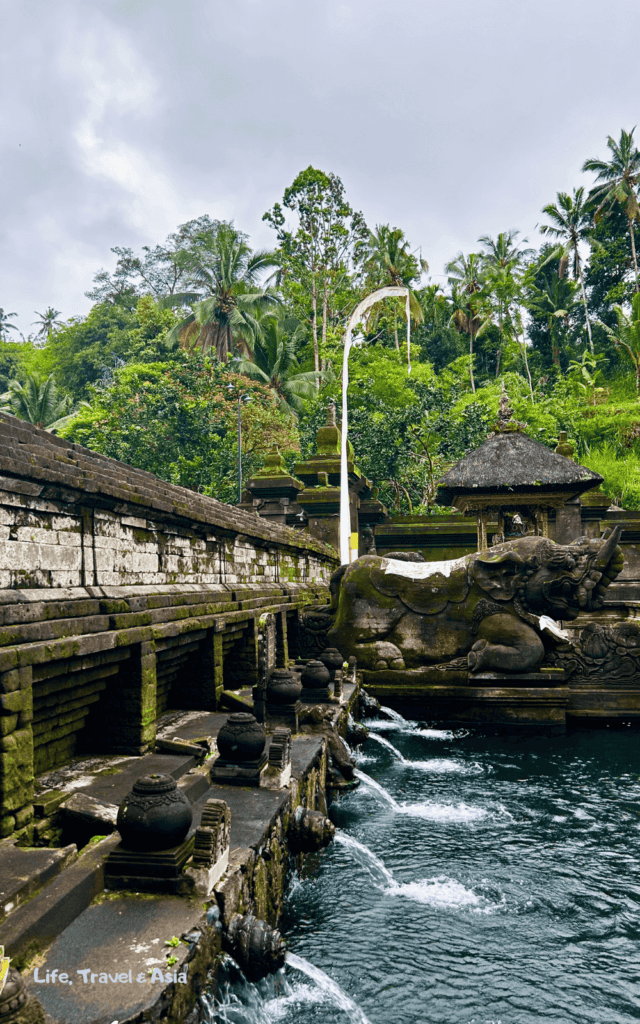
Later, after I moved to Bali and performed the ritual at Pura Mengening, my local guide casually mentioned that most Balinese no longer go to Pura Tirta Empul for melukat. Since then, I’ve heard the same from several people.
So while I do still recommend visiting the temple — its history and setting are incredible — I don’t think the purification ritual here feels as authentic or spiritually intimate as it can be in other Bali temples (which I’ll share at the end of this post).
Other Things To Do At Pura Tirta Empul (Beyond The Ritual)
The funny thing is that most visitors go to Pura Tirta Empul to perform the purification ceremony. Still, they somehow overlook the rest of the temple grounds, which, honestly, was what I loved the most about my visit.
Pura Tirta Empul is divided into three separate courtyards you can explore:
- Outer Courtyard or Jaba Pisan: Where most visitors gather to prepare for the rituals, get changed, and where the prayer part of the ritual is performed. Besides the altar, you’ll find a lovely koi fish pond hidden on the left-hand side of this courtyard.
- Central Courtyard or Jaba Tengah: This is the busier courtyard, home to the three bathing pools.
- Inner Courtyard or Jeroan: The most sacred part of the temple (and the one I loved the most), where locals gather for rituals and prayers. Here you’ll find the heart of the temple: the holy spring.

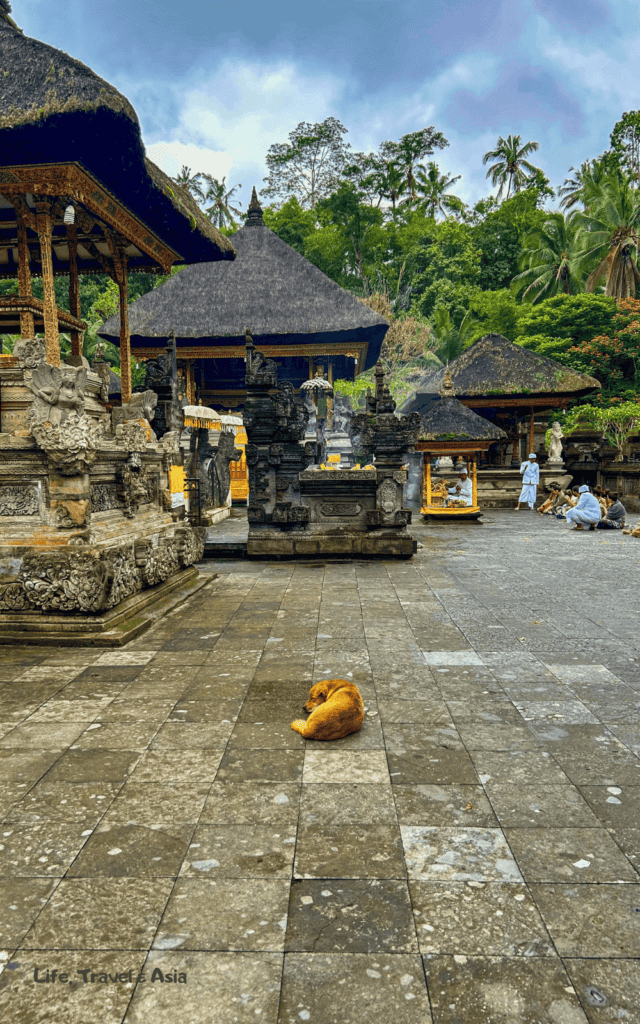
To get to the Jeroan, take the left-hand alleyway past the bathing pools, and you’ll find a beautiful natural pool fed by a spring that has flowed for centuries —a powerful symbol of purity.
You’ll pass the main shrines and prayer areas as you continue along the path. Most of these are reserved for Hindu rituals and ceremonies, so you can’t actually go inside but can have a look from the outside.
Other Temples Where to Practice The Purification Ceremony
After living in Bali for a while, I visited other temples in the same area. While Pura Tirta Empul is definitely the most popular, there are smaller but still charming temples where your melukat could actually be way more meaningful.
If you don’t think the experience I described at Tirta Empul is for you, check out the temples below.
Pura Mengening
Pura Mengening is where I practiced my own purification ceremony, and I couldn’t be happier with the setting, the guide, and the overall experience. It’s basically attached to Tirta Empul.
I booked my session for 8 AM on a Sunday, and at the temple, it was just me with my guide, plus two Balinese women who were heading out.

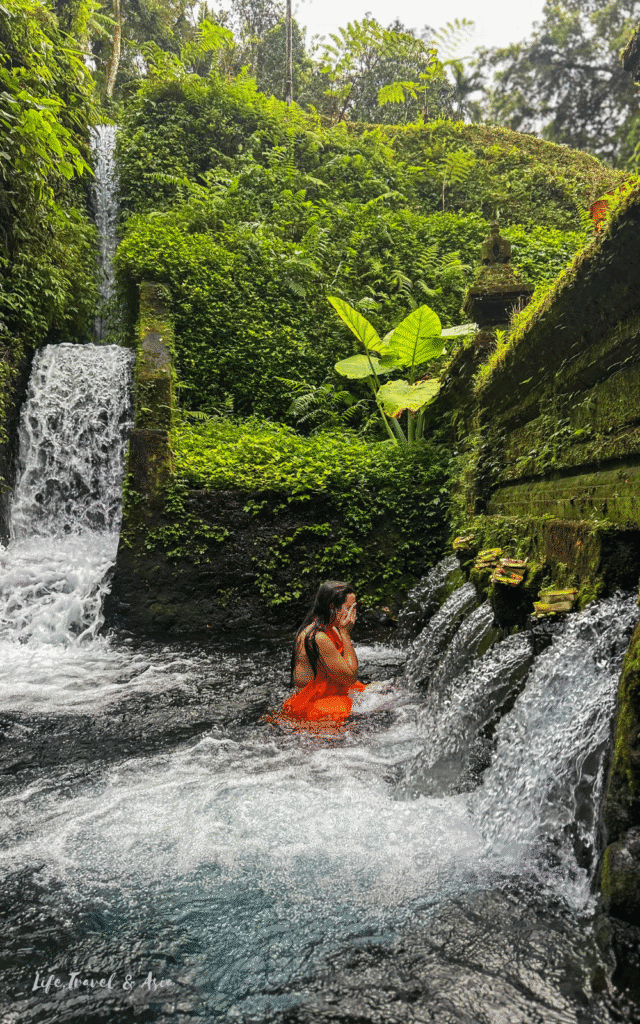
In this case, the guide truly made the experience: his explanation was clear, and he helped me tap into a deep sense of gratitude through his meditation. He chanted Hindu mantras the entire time and always provided clear guidance along the way.
Finally, the temple itself is simply beautiful. It’s small, but its unique structure — spread along the hillside, with stairs leading down to the bathing pool — makes it feel as if it were shaped by nature itself.
If you’re curious about how different a Melukat experience can be, I share everything about mine in this post about Pura Mengening and my own purification ceremony. And if you’re looking to book yours as well, this is the exact guided experience I booked.
Gunung Kawi Sebatu
Gunung Kawi Sebatu is probably the most enchanting temple I’ve seen in Bali so far. It’s on the smaller side, but its architectural details, crystal-clear pools, and the overall peaceful atmosphere more than make up for it.

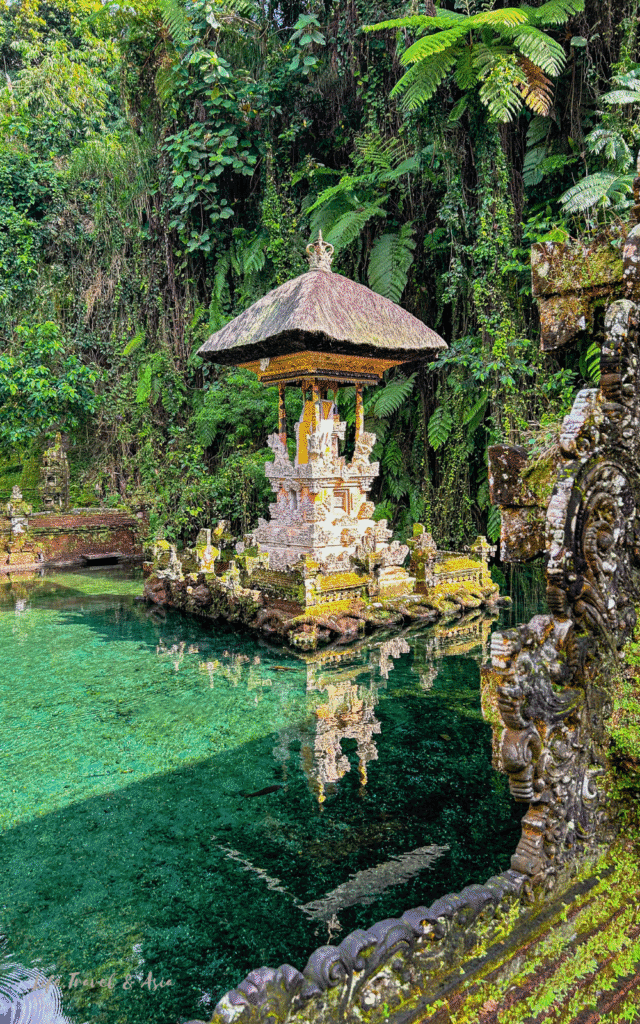
It’s a real hidden gem, so crowds aren’t usually an issue. If you want to be extra sure, aim to visit before 9 AM.
I didn’t take part in the ritual myself, but I watched a family of four go through it — and it was beautiful, meaningful, and incredibly calm.
If you’re curious about this tiny but beautiful temple, here’s what you can expect from your visit and ritual at Gunung Kawi Sebatu. If you feel that’s the right temple for your Melukat, you can book it here.
Other Things To Do Around Pura Tirta Empul
The valley of Tampaksiring is home to many other spiritual sights. Besides Gunung Kawi Sebatu and Pura Mengening, you can also plan to visit Pura Gunung Kawi Tampaksiring (I know… the names are confusing). This temple is particularly unique as it’s actually a funerary site.
The highlight here is definitely the massive shrines carved directly into the stone wall — it’s something you really have to experience in person.
If you’re interested in exploring other spiritual and religious sites in this area, make sure to check out my favorite temples in and around Ubud.


Another favorite stop on the way to Tirta Empul is usually the Tegallalang rice terraces, which open at 7 AM.
Tegallalang is one of the most popular spots around Ubud, so if you’d like to see the terraces in a quiet moment, I highly recommend stopping by around 7 AM. From 9 AM, the crowds really start to roll in.
So, there you have it — my honest take on the Pura Tirta Empul purification ceremony.
I absolutely loved the temple, but I personally wouldn’t choose it for my own Melukat experience. I hope this helped you plan your visit and make the most of your time in Ubud.
If you’re looking for both the must-see spots and the more underrated corners of the city, here’s my complete list of things to see, do, and try in Ubud — there’s everything you can imagine.
And if you have any questions about traveling to Ubud or Bali in general, feel free to drop them in the comments. I’m always happy to help! 🌿✨
Other Temples Worth Visiting While in Ubud
- Goa Gajah Temple: Ubud Elephant Cave and What Makes It Special
- Pura Ulun Danu Temple: Is It Worth the Hype? Honest Review & Guide
- Pura Besakih Guide: 10 Things I Wish I Knew Before Visiting Bali’s Mother Temple
Did you find it helpful? 📌 Save it on Pinterest!


